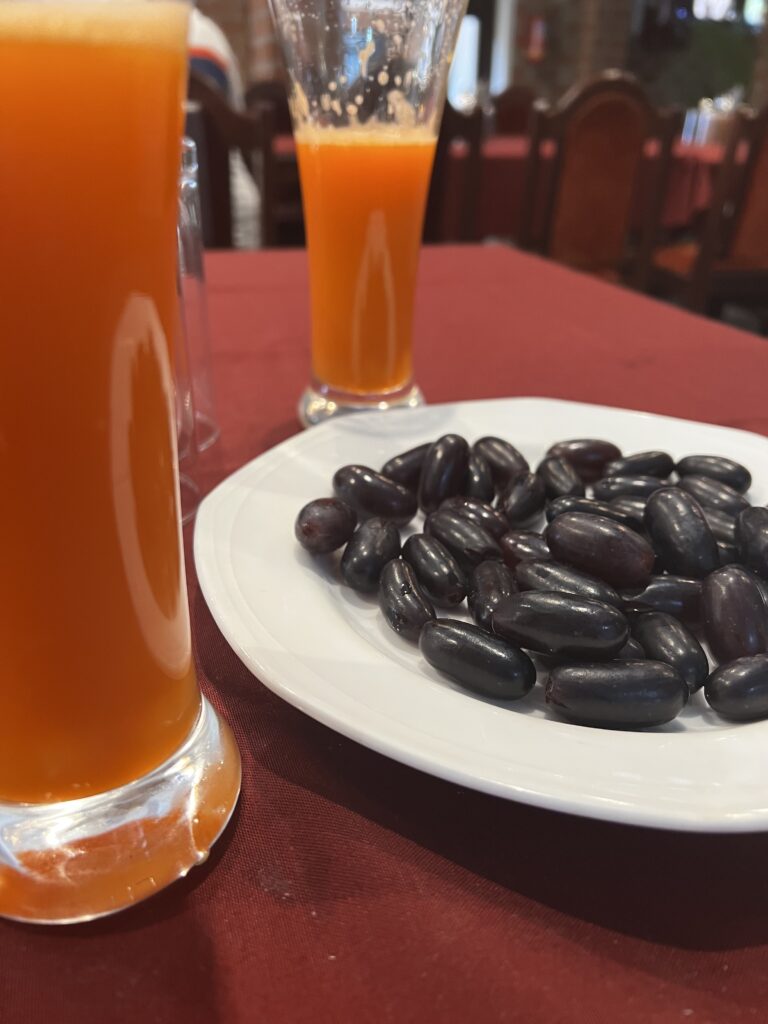Morning Rituals in Ayurveda: Why Fruit and Coffee May Not Be the Best Way to Start Your Day

In many modern wellness circles, starting the day with a fruit smoothie or a cup of coffee is often praised as energizing and light. But from an Ayurvedic perspective, these popular habits may be doing more harm than good, especially if they come before we’ve properly awakened our Agni, or digestive fire.
Why Ayurveda recommends a gentler approach to morning nourishment? how small shifts in your morning routine can have profound effects on digestion, energy, and clarity.
Understanding Agni: Your Inner Digestive Fire
Agni, the Sanskrit word for “fire,” represents not just digestion but the power of transformation, how we convert food into energy, thoughts into clarity, and experiences into wisdom.
Each day, our Agni follows the rhythm of the sun. Just as the sun rises slowly and reaches its peak midday, Agni starts softly at dawn. The early morning hours (6–10 AM) are governed by the Kapha dosha, which is slow, cool, heavy, and moist.
If you eat cold, light, or overly acidic foods during this time, you’re essentially throwing a cold towel over a fire you’re trying to light.
The Trouble with Fruit First Thing in the Morning
Fruit is often considered the ideal breakfast; light, hydrating, and full of vitamins. But Ayurveda views fruit a bit differently, especially when and how it’s consumed.
Why fruit may not be ideal first thing:
- Most fruits are cooling and watery; perfect for calming heat in summer, but not for kindling a sleepy digestive fire in the early morning.
- Cold fruit or juice dulls digestive enzymes, particularly hydrochloric acid (HCl), which is just beginning to build up after a night of fasting.
- Fruits digest quickly, but if your stomach isn’t ready, they can ferment, leading to bloating, gas, and sluggishness.
“Eating fruit too early is like putting cold water on a warm pan; it stops the heat before it can build.”
— Divya Alter, The Joy of Balance
Ayurveda recommends eating lightly spiced, warm fruit (like stewed apples with cinnamon) if you prefer something sweet in the morning. Raw fruit is better reserved for mid-morning, when digestion is stronger and the body is ready to metabolize it.
Coffee Culture: Why Your Morning Brew May Be Backfiring
Coffee has become a non-negotiable part of many people’s morning ritual. While it may provide a jolt of energy, it does so by stimulating the nervous system before the digestive system is even awake.
According to Ayurveda, drinking coffee on an empty stomach:
- Disrupts Agni by introducing acidity and dryness before digestion is ready.
- Aggravates Vata and Pitta, leading to anxiety, acidity, dryness, and in some cases, heart palpitations.
- Dehydrates the body, especially when consumed without water or food first.
“Drinking coffee first thing is like pressing the gas pedal with no oil in the engine.”
— Dr. Vasant Lad’s teachings
If you enjoy coffee, Ayurveda suggests having it after breakfast, ideally with warming spices like cardamom or cinnamon to help mitigate its stimulating effects.
Ayurveda-Approved Morning Routines
So what should you do first thing in the morning? Ayurveda offers a simple and nourishing rhythm:
- Hydrate with warm water, or tea with a slice of lemon, ginger, or cumin to gently wake the system.
- Eliminate waste before eating to avoid toxin reabsorption. ( here seriously another blog, that I will soon write soon ).
- Stimulate circulation and digestion with light movement (yoga), dry brushing, or pranayama (breathing techniques).
- Eat a warm, grounding breakfast; such as stewed apples, soft grains with ghee, or root vegetables.
- Wait until mid-morning for fruit, and enjoy coffee only after food if needed.
Classical Wisdom & Modern Appliccation
In the Charaka Samhita, one of Ayurveda’s foundational texts, the concept of Viruddha Ahara (incompatible food combinations) is key. Eating fruit with dairy, coffee on an empty stomach, or cold food during Kapha time are all seen as disruptions to digestive harmony.
Similarly, Divya Alter emphasizes that food must not only be nourishing; it must also be digestible. That means choosing the right time, temperature, and combination for your unique body type.
Final Thoughts: Build, Don’t Burn, Your Morning Fire
Ayurveda teaches us to approach the body like a sacred fire, one that needs care, attention, and patience to ignite. Starting your day with warm water, breath, and intention helps your digestion rise like the sun: steadily, powerfully, and with lasting energy.
Let your food be warm. Let your rituals be gentle. Let your mornings be medicine.

Respecting the Natural Order of Digestion
Ayurveda teaches not just what to eat, but how and when to combine foods for proper digestion and absorption. This is especially helpful if you’ve tried changing your diet but still deal with bloating, gas, or sluggish digestion.
General Rules of Ayurvedic Food Combining:
- Fruit is best eaten alone. Especially on an empty stomach, between meals, or as a light snack.
- Avoid combining fruit with dairy (like milk or yogurt), or heavy grains like oatmeal.
Why Not Fruit + Milk (like oatmeal with berries)?
Fruits are considered part of the sweet taste (madhura rasa) and are juicy, light, and quick to digest. Milk, on the other hand, is heavier, cooling, and slower to digest due to its unctuous (snigdha) and building (balya) qualities. Grains like oatmeal fall in the same slow-digesting category.
When you mix fast-digesting fruit with slow-digesting milk or oatmeal:
- Your body prioritizes digesting the heaviest substance first; the milk or grain.
- The fruit is left to sit in the gut and ferments before it’s processed, leading to gas, bloating, and loss of nutrients.
- So yes, that beautiful bowl of organic blueberries over oatmeal may look pretty; but it’s likely being wasted in your gut before it ever gets absorbed.
“Fruits are best eaten alone. Combined with milk or other foods, they can ferment and create ama, leading to imbalance.”
— Dr. Vasant Lad, “The Complete Book of Ayurvedic Home Remedies”
“Combining raw fruits with cooked foods is one of the main causes of digestive upset.”
— Divya Alter, “What to Eat for How You Feel”
“One should not take milk together with sour substances, salt, or fruit… such combinations are incompatible.”
— Charaka Samhita, Sutrasthana Ch. 26 (Viruddha Ahara)
Of course, everything shared here depends on you; your constitution, your current state, and the strength of your Agni
If you’re not sure where to begin or want to learn how to apply these principles in your own life, I’d be happy to help.
💬 Feel free to reach out for a free 15-minute call to see if there’s something I can support you with.
📧 Just send me an email or text—I’d love to connect.
The Healing Power of Marma Therapy
Where Touch Meets Consciousness

In the ancient healing system of Ayurveda, balance is everything; not just physical health, but emotional well-being, energetic flow, and mental clarity. One of Ayurveda’s most beautiful and powerful healing tools is Marma Therapy: the art of awakening the body’s subtle energy points through intentional touch.
🌿 What Is Marma?
The word Marma comes from the Sanskrit root “mri”, meaning “vital” or “to kill.” Marma points are considered sacred intersections of body, mind, and energy. These points lie where muscles, bones, joints, and ligaments meet prana, the body’s life force.
There are 107 major marma points on the body, each acting as a doorway to your inner healing system. When touched with awareness, these points can help release stuck energy, stimulate organ function, and restore the body’s natural intelligence.
Marma therapy isn’t about force—it’s about listening. A soft touch can spark a deep response.
🌿 What Happens in a Marma Session?
A Marma session is gentle, grounding, and deeply restorative. Here’s what you might experience:
- Gentle pressure on specific marma points using fingers, warm stones, or herbal tools
- Application of Ayurvedic oils like Dashamoola (detoxifying), Bhringaraj (rejuvenating), or Brahmi (calming the nervous system)
- Optional use of essential oils (lavender, frankincense, rose) to support mood, emotional release, and deeper relaxation
- Time to rest and receive, as your body unwinds and restores from within
Each treatment is tailored to your constitution and current condition; whether physical discomfort, hormonal imbalance, anxiety, fatigue, or simply the need for a reset.
🌿 Why Marma?
Clients come to Marma therapy for many reasons. It supports:
- Pain relief (neck, back, joints)
- Digestive balance and improved metabolism
- Hormonal support for menstruation, fertility, thyroid, or menopause
- Calm and clarity for stress, insomnia, or emotional heaviness
- Facial rejuvenation and improved skin tone
- Circulation of prana, the vital force that nourishes body and spirit
After a session, people often describe feeling lighter, clearer, more present and deeply relaxed.
🌿 Rooted in Ancient Wisdom
Marma therapy is grounded in the Sushruta Samhita, one of Ayurveda’s classical medical texts. These ancient teachings warned that trauma to marma points could be fatal, hence the name. But in therapeutic practice, we now use them not for harm, but for healing and transformation.
By applying oil and attention to these points, we stimulate the body’s inner pharmacy and reconnect with our original rhythm—the place of balance and inner knowing.
🌿 My Approach
In my Marma sessions, I use a blend of Ayurvedic herbal oils and pure essential oils, chosen based on your dosha and current needs. Whether you’re struggling with chronic stress, feeling disconnected, or simply craving deep rest, this gentle practice can help you reconnect to yourself on every level.
It’s not just bodywork, it’s nervous system repair, and a form of loving presence.
🌸 Ready to Experience It?
If you’re curious about Marma Therapy or feel drawn to a more holistic, intuitive path of healing, you’re welcome to book a session at Chula Vista Yoga and Ayurveda Living by ME.
Your body already holds the wisdom. Let’s help it remember.
Book your session: Book Now
Or call/text: 619-576-7954
The Common Cold
Do you remember your mom or your grandma saying… “you got sick because you went outside when it was hot and you had the AC on” or “you had the heater on and went outside when it was cold, and you were uncovered, so you got sick.”
According to Ayurveda, a common cold, or respiratory disease can be caused by exposure to a cold environment (weather, foods etc…). Combined with change (mobility, traveling), dryness, overexertion or a light diet and you have a recipe for getting sick. Also, changes that include: seasonal changes, change of jobs, relationships etc…those changes also create stress, which makes the body weaker. Your Vitality or Immune system (Ojas) are low due to overdoing any of the above or combination of one or two of these.
According to Ayurveda, all sickness or disease starts in the digestive system. How does this happen in the digestive system? What? Yes, that’s right.
Picture How easy it is to get a cold, or any disease, when you overdo or continuously repeat the same patterns over and over.
If your doshas are more predominantly (Vata air- ether) and you have been Traveling for a few days, eating “Bad food” for your dosha, Like I did (Green Juices, Coffee, pushing the adrenals to keep going, eating dry, fried, spicy food, no routines around meals for days), these can easily aggravate your dosha and bring it out of balance.
If you are more Pitta (fire and water), maybe you experience more heat and intensity. The Intensity of the day to day struggles or over exercise, homework, can all contribute to a weaker immune system. It could also be related to the food intake, eating salty, pungent and sour foods. Again, any type of change, seasonal and weather, etc…can all make it easier to get sick.
If you are more Kapha, then the onset occurs after a period of consuming an excess of cold foods, too much sweet, sour or salty foods. Exposure to cold, damp weather, can bring on a cold. You might think about how we tend to eat a lot and watch Netflix and over indulge during the winter and colder months, then in spring, we get allergies or a cold. All that excess consumption catches up. The excess “water and earth“ food (heavier foods like cakes, holiday dinners, comfort food, etc.), that we consume during the colder months, starts to melt, just like a snowy, white topped mountain starts to melt during the spring.
It all starts with the Accumulation of toxins. This happens in different parts of the digestive system. That is the reason we all Experience different symptoms when we get a cold, flu or any respiratory disease.
Vata- more dry cough (not too much mucous), pain and fatigue.
Pita- more heat, inflammation. Fever.
Kapha- congestion, more mucous, phlegm. Lethargic.
Depending on where the accumulation happens, those are the symptoms you experience.
In Ayurveda The treatment is to bring In the opposite qualities to alleviate the doshic imbalance. In Ayurveda, we like to say “like increases like and opposites balance each other.”
What to do? Well, maybe call your doctor if you feel super sick.. don’t listen to my nonsense, lol.
Or…you can also start by first, bringing the digestive system back to balance; maybe fast one day. This will be really helpful (consult with your doctor or Ayurvedic practitioner to make sure you can fast).
Why fast? It will help normalize the digestive enzymes. Giving your digestive system time to recuperate and ignite that fire (digestive enzymes) within us; ridding us of toxins or accumulated food that has been trapped in our digestive track.
Drinking Ginger tea or pickled ginger to avoid nausea and bring the Agni (digestive fire) back to normal. Coconut water or natural electrolytes to avoid dehydration.
REST, REST, REST AND MORE REST.
Yoga Nidra is wonderful (I always remember my dear friend and teacher telling me about the benefits of this practice. Well, It’s truly magical. Try to practice it, once in a while. You will love it. And when you are sick, 2 or 3 times a day is even better.
Colds indicate a weakness of the immune system (Ojas). They occur as a result of living out of harmony with our nature. You can look at a cold as a message from your body telling you that you are living out of harmony. Hopefully, you will make a change. If you don’t, then that cold will turn into a disease or illness.
Take, at least, 3 days off and rest. Use this time wisely to see where you have been lacking or overdoing. Ayurveda is translated as a science or knowledge of life, study of your life. Self study.
Neti pot with Himalayan salt (sometimes with herbal preparations according to your dosha).
Eye wash with Rose water
Light diet or fasting: (soups.. yes soups are easy to digest, and very simple to make. Maybe you recall your mom making you that chicken soup when you were sick. You needed that soup; that watery content, full of nutrients to replenish all the liquids of the body. Adding spices to digest, and bring back nutrients into our body, so we can remove all that is not serving us.. (mug dalh soup, with spices like ginger, turmeric, dry fennel seeds, cumin, cinnamon, maybe topped with cilantro). Veggie soups are also easy to digest, don’t use too many ingredients though.
Imagine you want to bring moisture and warmth into your body. For Kapha, add more pungent herbs.
Enemas -(enemas (bastis) purgations, therapeutic vomiting can be done at the onset of condition).
Nasya – (oils in the nostrils with herbal preparations according to your dosha).
Lemon, honey and water if you have sore throat…herbs can be added too.
Baths, with essential oils. Daily.
Pranayama (pranayama is essential. Maybe talk to your yoga teacher or Ayurveda practitioner to ask which practices will benefit you the most).
These are some of the things I do to help me get back to balance from my cold which is more predominantly vata and Pitta, of course.
The excessive movement and intensity of the last couple of weeks made my Ojas lower and the exposure to different climate changes made my body react. Now, here I am turning this illness into a positive.
Hope you can find some understanding to my rambling…lol.
Living your Ayurveda Life !
Finding Balance
Your current health is the result of your daily habits. You want to feel strong, have energy at the end of the day and wake up with vitality. Do you need willingness to move and to be ready to start your day?
Start paying attention to where your energy goes every day.. Ayurveda and yoga teach us to be a witness. The foods and daily routines are fundamental to our health.
A yoga practice teaches us to be present and conscious of our body movements. It’s not just getting into a pose; it’s feeling the pose, where the energy of that pose is going.
Same with food; feeling the energy that food gives you as fuel. At the end of the day, that is your fuel
So what kind of fuel are you giving your body?
One that is going to make you tired, heavy, and take all your energy away?
Or food that gives your body real fuel, foods with prana (energy) to nourish your body inside and out !


